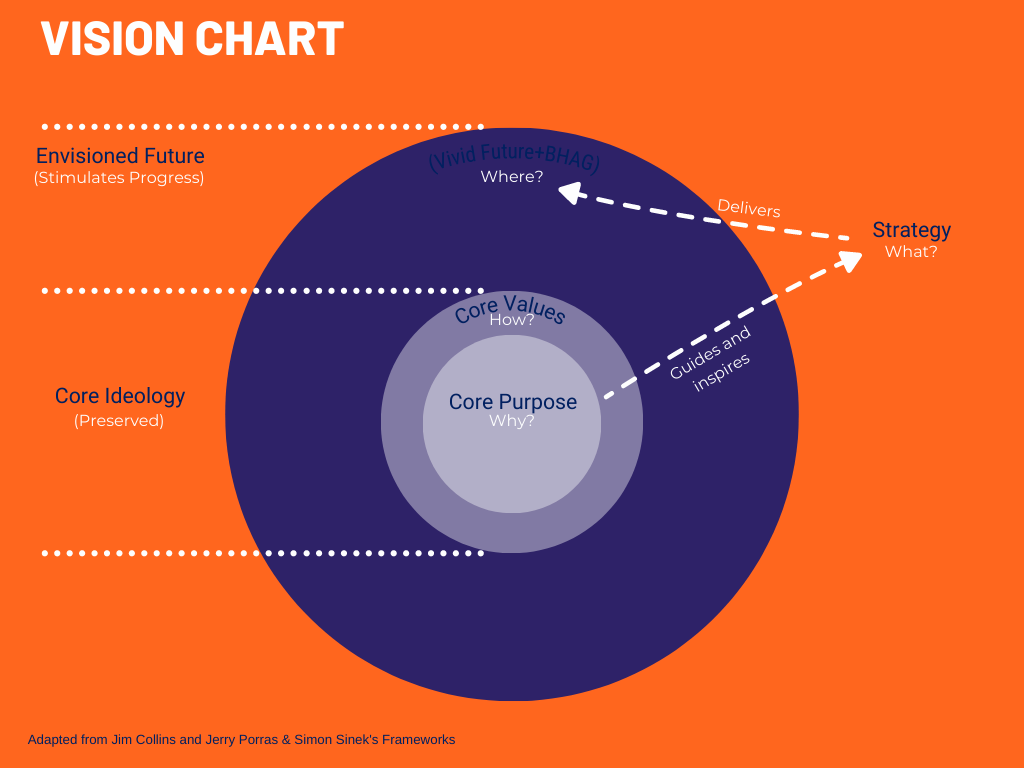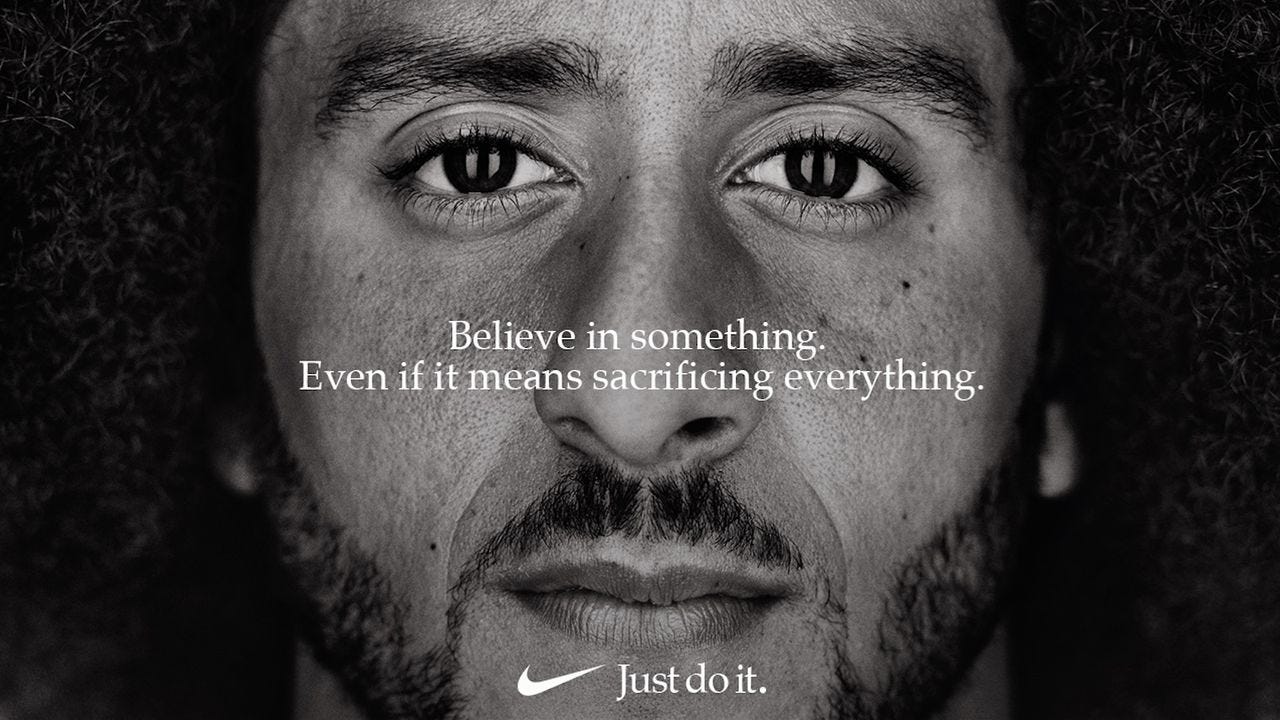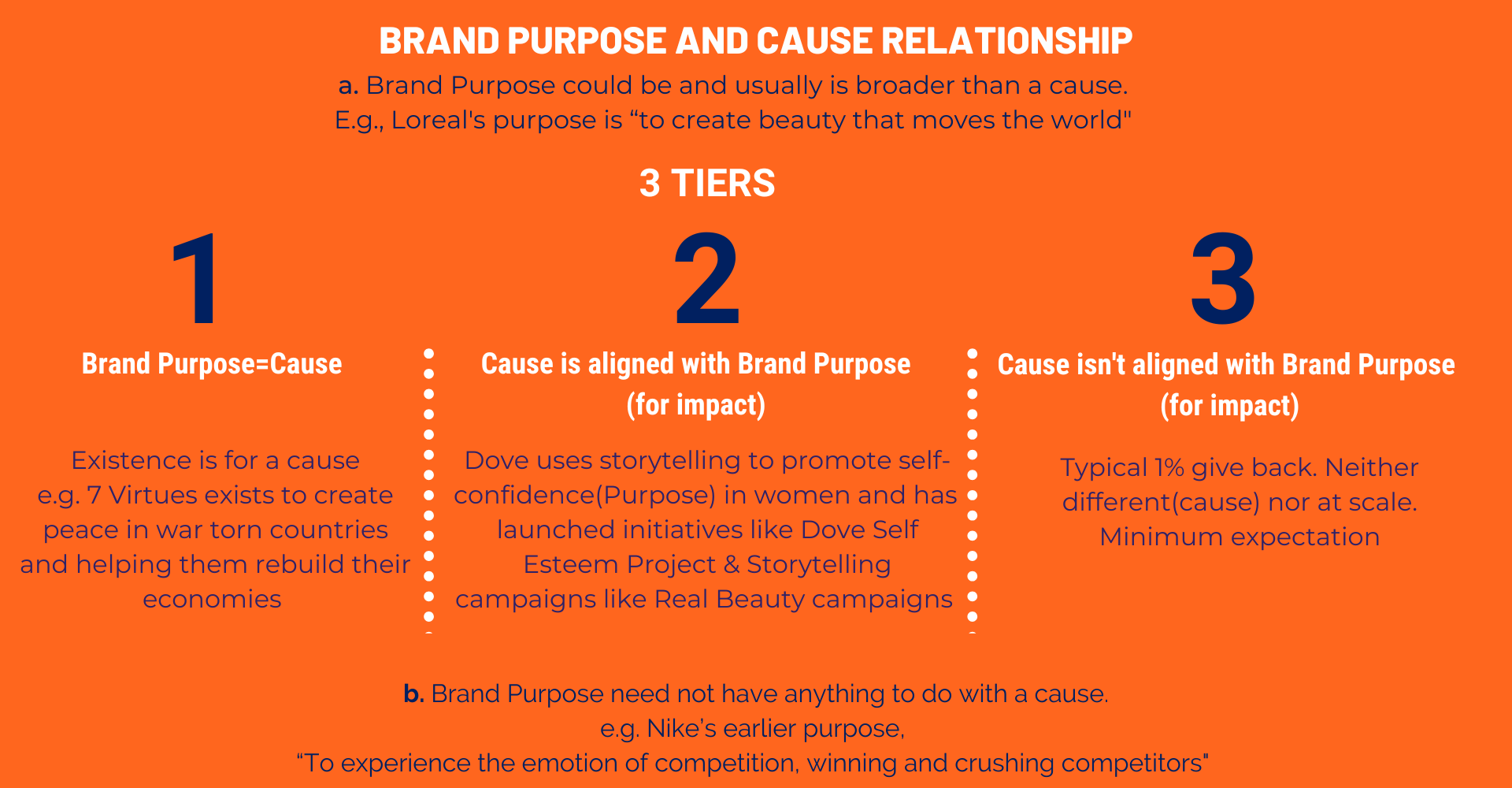What is Brand Purpose, what isn’t, how to find it, and is it important to have one?
Brand Purpose could be used for your positioning especially if it is also a cause.
This article covers, amongst other topics,
-Definition of brand purpose
-Where does purpose sit in the vision chart
-Objective of brand purpose
-Difference between brand purpose and cause
-How to discover brand purpose
-What isn’t brand purpose-myth busting
Definition of Brand Purpose:
The Why?
Purpose is a brand’s raison d’être. Why did the founder/founders or the organization decide to create the brand in the first place beyond commercialization?
We all have met at least one entrepreneur who is gung ho about the idea, product, or venture! More often than not, she/he/they would be talking about changing the world. The “why” behind changing the world is their purpose.
A product or a brand isn’t created merely for sales but to solve a problem. Money is a reward you get for giving the solution. The purpose is a “perspective or a reason” that gives the problem and its solution a meaning beyond a mere business transaction.
“An effective purpose reflects people’s idealistic motivation for doing the company’s work,” Jim Collins and Jerry Porras.
Purpose inspires passion. In the words of Simon Sinek, “Working hard for something you don’t care about is called stress. Working hard for something you love is called passion.”
Where does the Brand Purpose Sit in the Vision Chart
(adapted from Jim Collins and Jerry Porras framework in their book “Built to Last” and Simon Sinek’s book “Start with Why”)

Purpose sits at the core of an organization’s vision.
Why?-Core Purpose-reason for existence
How?-Values-how you behave while driving the purpose
Along with the how, purpose forms an organization’s core ideology, as Jim Collins described.
What?-Strategy beyond products and services you deliver
Where?-Envisioned Future (coined by Jim Collins):BHAG(Big Hairy Audacious Goal(10 to 30 years) + Vivid Future (See, think, hear and feel)-
Where do you want to reach under the guidance and inspiration of purpose, living up your values and with a strategy unique to your brand.
According to Jim Collins, “purpose, along with core values, is to be passionately preserved while your Big Hairy Audacious Goal stimulates progress.”
Why do You Need a Brand Purpose?-Objective of Purpose
The objective of the purpose is to guide progress towards and beyond the desired future(vision). With the same purpose, you could envision and achieve multiple, sequential BHAGs.
-Guide and Inspire
Brand Purpose’s primary aim is to guide and inspire employees, who guide and inspire stakeholders, including partners and vendors. It could even motivate consumers. Ultimately, consumers are impacted by purpose, whether they are consciously aware or not.
The purpose is critical for both a start-up and a big brand.
e.g., Glossier founder Emily Weiss’s “why” was to democratize beauty. The fact that the brand uses real people’s feedback to create products, is priced effectively, and sold DTC is the strategy that is aligned with the core purpose.
-Reduce Attrition(Improve Retention)
Easier to sell a purpose-driven brand than offer a transactional relationship to key employees and stakeholders earlier in the brand lifecycle when you don’t have resources to provide the best of paychecks and perks. It is also more challenging for the first few hires to deliver results initially, so a purpose motivates the right fit employees.
“Giving voice to the customer through beauty” is the first and the most prominent reason Glossier cites on their website to attract talent.
-Ecosystem Creation and Brand Tribes
You cannot operate in isolation. Purpose can help create an ecosystem of vendors, partners, influencers, etc., that join forces to fulfill the shared drive. Everyone looks up to and wants to associate with those who demonstrate leadership in a domain of interest.
Further, it is much easier to mobilize support outside of your organization for your venture if your brand purpose is also a cause. E.g., The 7 Virtues-Make Perfume and Not War, a Canadian fragrance brand that sources essential oils distilled through legal crops from countries that need rebuilding helps provide a safe and eco alternative to the illegal poppy crop and its violent drug market.
In two weeks, the brand was on the front page of the Globe and Mail, and 8 weeks after that, Barb Stegemann became the first woman from Atlantic Canada to land a venture capital deal on the Dragon’s Den.
First local cooperatives, and then countries started inviting Barb to buy the ingredients from their geographies and help rebuild their local economies.
Please note: This does not mean that it’s easier to create a purpose-driven brand or business. What I mean is that, sooner than later, those who truly matter, appreciate and understand your purpose-driven intent and its potential impact, and are willing to support you.
The more you are driven by purpose, whether cause-oriented or not, the easier it is to create your brand tribe and get free press.
-Guidance for Vision(7 years/10 years BHAG-Big Hairy Audacious Goal)
Without a brand purpose, you would create a vision/BHAG in a vacuum without inspiring much action.
e.g., Nike’s core purpose is “to experience the emotion of competition, winning and crushing competitors,” and their BHAG in the 1960s was “Crush Adidas.”
Their mission statement, “Bring Inspiration and Innovation to every athlete” (*If you have a body, you are an athlete), reflects the core purpose.
Please note, Nike claims to have broadened its purpose within the context of recent global movements and awareness to “Our purpose is to unite the world through sport to create a healthy planet, active communities and an equal playing field for all.”
One could argue that this broadened purpose is furthering their Corporate Social responsibilities and causes the brand believes in, which are well aligned with their target segment, category, and to an extent with their core purpose.
To be fair, it seems a genuine attempt to truly broaden their purpose, as demonstrated by some of the brand’s public stances, such as raising voice against racism with the Colin Kaepernick ad campaign.

My only advice would be not to lose the clarity they had behind their “why.”
I am also eager to see how holistically (product & retail innovation, culture & communication) the brand reinvents itself around the stated broader purpose.
-What after Strategy delivers 10-year BHAG(Big Hairy Audacious Goal)?
Purpose helps guide the creation of a new BHAG, after you have achieved the initial.
Brand Purpose and Cause

Brand Purpose need not be a cause nor have anything to do with a cause, and could be equally powerful if not more.
e.g., Nike’s earlier purpose mentioned above, “to experience the emotion of competition, winning and crushing competitors.”
Brand Purpose and Cause Relationship-3 Tiers
Brand Purpose could be and usually is broader than a cause. Purpose takes much higher significance in this case, with associated cause offering specificity.
Master Brand Loreal Example-Core Purpose of Company Independent of a particular Cause-Create the Beauty that moves the world.
Loreal participates in causes aligned with their core purpose of creating beauty that moves the world. The company stands up for human rights, encourages women empowerment through sourcing, and is aiming for carbon neutrality by 2050 amongst a whole lot of other cause-oriented strategic initiatives that are perfectly aligned with their core purpose.
1. Brand Purpose is a Cause
e.g. 7 Virtues, Ten Tree or Patagonia
7 Virtues: As shown above (Objective of Brand Purpose)
In this case, brand purpose needs to be communicated emphatically to the end consumer as the cause could drive preference for the brand, and vice versa, meaning the more the brand is bought, the more the cause, which is bigger than the organization, would be supported.
Also, the net contribution to a cause is the highest with the whole brand organized around the core purpose=core cause for this tier.
2. Cause is Perfectly Aligned with Brand Purpose for Impact
Dove uses storytelling to promote self-confidence(Purpose) in women. Dove regularly raises awareness for causes such as stereotyping women, real beauty, etc. But, the brand was not created with that purpose at the center and was transformed emotionally in response to business stagnation. It remains a cause-driven brand in that the brand either raises awareness for a cause through storytelling or contributes to a related cause but the entire business wasn’t built around the sole cause like 7 Virtues, Patagonia or Ten Tree.
Beyond mere storytelling to raise awareness, the Dove Self Esteem Project has engaged, since 2004, hundreds of thousands of teachers, parents, youth leaders delivering the Dove self-esteem and body confidence education to over 20 million young people across 139 countries and are targeting another 20 million by 2020.
The brand has the core purpose and causes very closely aligned now. Still, it sure must have taken some doing, and will always have to overcome the kind of doubt I am casting for anyone evaluating the brand for both its claimed purpose and it also being driven by a cause, especially those who have partnered with the brand or worked with Dove since before transformation and all the consumers who have been exposed to pre-transformation communication, service, and innovation.
3. Cause is not Aligned with Brand Purpose for Impact
Typical 1% givebacks. Consumers expect that as a bare minimum—falls under Corporate Social Responsibility. Neither different(cause) nor at scale.
How to Discover Brand Purpose
-5 Whys
(Jim Collins and Jerry Porras)
Start with a descriptive statement, “we make X products,” then ask why is that important 5 times. After a few whys, you will get to the fundamental purpose of the brand.
e.g., A pro-aging skincare could start with “we make pro-aging skincare products.”
Why is that important?-” So people can age gracefully.”
Why is that important?-” So people can feel confident while aging”
Why is that important?-“So people can focus on truly living their lives with all the wisdom accumulated.”
Why is that important?-“To improve the quality of life with age.”
Why is that important?-“To make people look forward to and appreciate aging and remove the taboo around aging.”
-Irreplaceable Gift to the World
Another approach is to ask people with the most credibility and competence in the company, “If the organization were to cease to exist, what would the world miss, which is irreplaceable and holds deeper meaning beyond functional utility?”
Brand Purpose Myth Busting

1. Inside Job vs. Profit Impact or Reverse Engineering
According to Nick Kemp – Ikigai Coach, your Ikkigai-purpose is not about what the world needs, nor is it about making money. As Jim Collins & Jerry Porras state, the purpose has to do with your internal motivation to bring some change in the world irrespective of the size of impact or commercialization opportunity.
In my opinion, the size of impact could be a purpose for someone, but commercializing that impact would not be.
When Walt Disney wanted to make people happy, he did not size the market for evaluating profitability, nor did he debate in his mind whether people would like to be happy or not. His internal motivation to make them happy mattered more than working backward from what the world needs. This one is a bit tricky but will help you discover a more real purpose than working back from the consumer/world need.
E.g., It is highly debatable whether the world needs Space X, but not to Elon Musk. He is absolutely convinced in making humans an interplanetary species. A lot of times, he has cited working on Space X akin to waking up as a child every day fascinated by extraordinary imagination.
2. Discovered not Invented
Purpose is not created but discovered. Don’t worry about the perfect composition statement but just “why you started in the first place.” Purpose is not to impress the world but to guide meaningful work.
3. Independent of Differentiation
Brand Purpose is not your differentiation. Two brands could have the same purpose and values. They will most probably go about achieving it differently.
4. Work in Progress vs. Envisioned Future-BHAG (Vision)
Purpose guides progress towards an envisioned future but is not a BHAG-Big Hairy Audacious Goal, which you achieve in 10-30 years.
Brand Purpose is always a work in progress and should easily guide progress for 100 years. A Purpose could drive towards 3-10 subsequent envisioned futures/visions.
5. Not for Flaunting
You don’t have to show off your purpose to the end consumer with the hopes of increasing revenues but preserve it for guiding and inspiring employees.
6. Purpose isn’t your Strategy or Advertising Tactic in the Guise of a Cause
Since a cause offers the potential to motivate consumers in addition to employees and closer stakeholders, it is very tempting for a brand to portray its purpose as a cause, even when the reality could be far from it.
For example, Gillette ad tried to raise a societal issue of toxic masculinity in total contrast to what the brand’s messaging had been for decades. The ad did not go well with their loyal consumer base, and some outside of their consumer base too saw it as a cheap tactic to benefit from the heightened social awareness.
Misunderstood
-Warby Parker’s on “Fit and Style” matters more than Charity
When the Warby Parker team openly stated that the fit and style matter more than their 1+1 charitable program, it was inferred that you don’t always need a brand purpose.
Again, a charitable program is a cause, and rightly so, it is not a necessity(purpose). But, Warby Parker started for a different reason, their purpose, “to make buying glasses inexpensive so everyone can see” then elaborated as “buying glasses should be easy and fun. It should leave you happy and good-looking, with money in your pocket.”
The social mission, buy one and give one, came later, and the whole brand wasn’t designed around that charitable cause like Tom’s Shoes or Ten Tree.
Warby Parker’s raison d’être(purpose) was not charity in the first place even though the Co-CEO, Neil Blumenthal, explicitly states that their social mission is what drives them everyday, and is the reason people want to come and work for them.
The brand seems to have perfectly aligned their social mission with its purpose, with Neil admitting that the mission is a motivator for internal employees.
-Leading Strategy Consulting Company’s Report on the Importance of Purpose for Brand Success
(Don’t want to name the company as that’s not important)
The report cites causes, that are universally relevant and are needed for both the protection and progression of our environment, civilization, and society. These cause-driven initiatives come under corporate social responsibility and might not be the core purpose of an organization/brand.
It rightly states that brands owe to the community but fails to distinguish between a core brand purpose and a cause, which is a minimum public expectation or could even advance society/civilization and be rewarded by a consumer not disqualifying a brand from their consideration set. However, CSR alone won’t help you excel as a brand or a business.
While UK retailer John Lewis’s(example in the report) move to do away with “Boys” and “Girls” labels in children’s clothing, to express its stance against gender stereotyping, is an appreciable initiative advancing society, in line with a cause the brand feels responsible towards, it isn’t the core purpose of the retailer’s existence or might not even be perfectly aligned with the core purpose.
Non-Gender Specific–a brand for all humans-is an inclusive skincare brand for all genders, all skin types, and all skin tones.
Even without a single mention on the website of any charitable causes, it contributes to, equality of all genders is the brand’s core purpose.
Unlike the report states, and mentioned in the brand purpose myths before, the purpose isn’t your differentiation, need not be unique, and is not more relevant to particular brand categories.
Summary on Report: Mistook causes and CSR for a Brand Purpose.
To their credit, it makes sense to say that cause-driven brands are resonating with consumers, cause they do value brands taking responsibility & showing leadership, which could help in brand profitability by making consumers include those brands in their consideration set.
Nevertheless, the primary audience of the brand purpose is the internal employees and stakeholders driving strategy and execution.
Conclusion
Brand Purpose is the why, the reason for a brand’s existence. It sits at the core of the vision, guides and inspires progress towards an envisioned future, which is your vividly imagined Big Hairy Audacious Goal.
Brand Purpose is not necessarily the cause the company contributes to. A cause could be the core purpose of a brand, but it could also be perfectly aligned with the purpose or could merely be an initiative tactic like Corporate Social Responsibility, a minimum expectation from brands today.
You could discover your brand purpose through 5 Whys or Irreplaceable Gift frameworks.
Brand purpose is aimed at employees, and close aides, isn’t differentiation, is an inside job and not reverse engineering, isn’t created but discovered, and isn’t meant to be flaunted but honored.
Loreal is a great example of a corporate brand dedicated to the purpose of “creating beauty that moves the world” while 7 Virtues is an Indie brand with a very clearly defined brand purpose driven by a cause.
What is the reason you or the founder started the beauty brand? What would the world truly miss if your brand ceases to exist tomorrow?
Jump accelerates women-led, early-stage beauty brands with a fit, full & fundamental solution using the first principles of science & emotion.
Let’s together create “A Woman’s World.”

